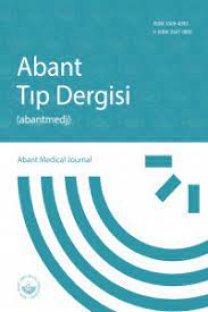Mesobuthus gibbosus (Scorpiones: Buthidae) Akrep Ham Zehrinin Kanser Hücre Hatları Üzerine Sitotoksik ve Antiproliferatif Etkilerinin Araştırılması
Akrep Zehri, Mesobuthus gibbossus, Kanser, Hücre Proliferasyonu, Sitotoksisite
Investigation of Cytotoxic and Antiproliferative Effects of Mesobuthus gibbosus (Scorpiones: Buthidae) Crude Scorpion Venom on Cancer Cell Lines
Scorpion Venom, Mesobuthus gibbosus, Cancer, Cell Proliferation, Cytotoxic,
___
- 1. Sağlık Bakanlığı Tedavi Hizmetleri Genel Müdürlüğü. Türkiye Onkoloji Hizmetleri Yeniden Yapılanma Programı 2010-2023. Ankara: T.C. Sağlık Bakanlığı. 2010.
- 2. Tuncer M. Globalleşen Kanser ve Türkiye. 2008. www.nukte.org.
- 3. Brawley OW. A brief history of the American cancer society extramural research program. CA Cancer J Clin. 2013; 63(1):9-10.
- 4. Baskar R, Lee KA, Yeo R. Cancer and radiation therapy:current advances and future directions. International Journal of Medical Sciences. 2012; 9(3): 193-199.
- 5. Santibáñez-López CE, Possani LD. Overview of the Knottin scorpion toxin-like peptides in scorpion venoms: Insights on their classification and evolution. Toxicon. 2015; 107(Pt B): 317-326.
- 6. Rein JO. https://www.ntnu.no/ub/scorpion-files/ 2022.
- 7. Ma Y, He Y, Zhao R, Wu Y, Li W, Cao Z. Extreme diversity of scorpion venom peptides and proteins revealed by transcriptomic analysis: implication for proteome evolution of scorpion venom arsenal. J. Proteomics. 2012; 75(5): 1563-1576.
- 8. Rodríguez de la Vega RC, Schwartz EF, Possani LD. Mining on scorpion venom biodiversity. Toxicon. 2010; 56(7): 1155-1161.
- 9. Almaaytah A, Tarazi S, Mhaidat N, Al-Balas Q, Mukattash TL. Mauriporin, a novel cationic α-helical peptide with selective cytotoxic activity against prostate cancer cell lines from the venom of the scorpion Androctonus mauritanicus. Int. J. Pept. Res. Ther. 2013; 19(4): 281-293.
- 10. Nabi G, Ahmad N, Ullah S, Khan S. Therapeutic Applications of Scorpion Venom in Cancer: Mini Review. Journal of Biology and Life Sciences. 2015; 6(1): 57.
- 11. Bradford MM. Rapid and sensitive method for the quantitation of microgram quantities of protein utilizing the principle of protein-dye binding. Analytical Biochemistry. 1976; 72: 248-254.
- 12. Ucar G, Tas C, Tümer A. Monoamine oxidase inhibitory activities of the scorpion Mesobuthus gibbosus (Buthidae) venom peptides. Toxicon. 2005; 45(1): 43-52.
- 13. Ucar G, Tas C. Cholinesterase inhibitory activities of the scorpion Mesobuthus gibbosus (Buthidae) venom peptides. FABAD J Pharm Sci. 2003; 28(1): 61-70.
- 14. Diego-García, E, Caliskan F, Tytgat J. The Mediterranean scorpion Mesobuthus gibbosus (Scorpiones, Buthidae): transcriptome analysis and organization of the genome encoding chlorotoxin-like peptides. BMC genomics. 2014; 15(1): 1-16.
- 15. Feng L, Gao R, Gopalakrishnakone P. Isolation and characterization of a hyaluronidase from the venom of Chinese red scorpion Buthus martensi. Comparative Biochemistry and Physiology Part C. Toxicology & Pharmacology. 2008: 148(3), 250-257.
- 16. Kesavan K, Ratliff J, Johnson EW, Dahlberg W, Asara JM, Misra P, ... & Jacoby DB. Annexin A2 is a molecular target for TM601, a peptide with tumor-targeting and anti-angiogenic effects. Journal of Biological Chemistry. 2010; 285(7): 4366-4374.
- 17. Veiseh M, Gabikian P, Bahrami SB, Veiseh O, Zhang M, Hackman, RC, ... & Olson JM. Tumor paint: α- chlorotoxin: Cy5. 5 bioconjugate for intraoperative visualization of cancer foci. Cancer research. 2007: 67(14): 6882-6888.
- 18. Heinen TE, da Veiga ABG. Arthropod venoms and cancer. Toxicon. 2011; 57(4): 497-511.
- 19. Wang WX, Ji YH. Scorpion venom induces glioma cell apoptosis in vivo and inhibits glioma tumor growth in vitro. Journal of neuro-oncology. 2005: 73(1): 1-7.
- 20. Omran MAA. Cytotoxic and apoptotic effects of scorpion Leiurus quinquestriatus venom on 293T and C2C12 eukaryotic cell lines. Journal of venomous animals and toxins including tropical diseases. 2003: 9(2): 255-276.
- 21. Fu Y J, Yin LT, Liang AH, Zhang CF, Wang W, Chai BF, ... & Fan X.J. Therapeutic potential of chlorotoxin-like neurotoxin from the Chinese scorpion for human gliomas. Neuroscience letters. 2007; 412(1): 62-67.
- 22. Sariego J. Breast cancer in the young patient. The American surgeon. 2010: 76(12): 1397-1400.
- 23. D’Suze G, Rosales A, Salazar V, Sevcik C. Apoptogenic peptides from Tityus discrepans scorpion venom acting against the SKBR3 breast cancer cell line. Toxicon. 2010; 56(8): 1497-1505.
- 24. Ortiz E, Gurrola GB, Schwartz EF, Possani LD. Scorpion venom components as potential candidates for drug development. Toxicon. 2015; 93: 125-135.
- 25. Zhang YY, Wu LC, Wang ZP, Wang ZX, Jia Q, Jiang GS, Zhang WD. Anti-proliferation effect of polypeptide extracted from scorpion venom on human prostate cancer cells in vitro. Journal of clinical medicine research. 2009; 1(1): 24-31.
- 26. Incesu Z, Caliskan F, Zeytinoglu H. (2005). Cytotoxic and gelatinolytic activities of Mesobuthus gibbosus (Brullé, 1832) venom. Revista CENIC. Ciencias Biológicas. 36.
- 27. Zargan J, Umar S, Sajad M, Naime M, Ali S, Khan HA. Scorpion venom (Odontobuthus doriae) induces apoptosis by depolarization of mitochondria and reduces S-phase population in human breast cancer cells (MCF-7). Toxicology in Vitro. 2011; 25(8): 1748-1756.
- Yayın Aralığı: 6
- Başlangıç: 2012
- Yayıncı: Bolu Abant İzzet Baysal Üniversitesi Tıp Fakültesi Dekanlığı
Üretrada Papillom Benzeri Görünümde Prostat Kanseri Düşünmeli miyiz?
Mustafa KÜÇÜKYANGÖZ, Emrullah SOGUTDELEN, Uğur ÜYETÜRK
Ömer BOZDOĞAN, Esra YAVUZ, Anıl TEMİZ, Şevval ÖZDEMİR
Gülru POLAT, Güneş ŞENOL, Aysu AYRANCI, Damla SERÇE UNAT, Filiz GÜLDAVAL, Merve AYIK TÜRK, İhsan TOPALOĞLU, Ömer Selim UNAT, Gülistan KARADENİZ, Fatma DEMİRCİ ÜÇSULAR, Enver YALNIZ, Melih BÜYÜKŞİRİN, Mahmut Mete DEMİREL
Meningiomlarda Ki-67 Proliferasyon İndeks Pozitiflik Sınır Değeri
Neşe YELDİR, Ezgi DOĞAN, Hatice ÖZER, Burçak SÖYLEMEZ, Serkan ÇELİKGÜN, Reyhan EĞİLMEZ
Klebsiella Variicola: Bir Bakteriyemi Olgusu ile Literatürün Değerlendirmesi
Şeyma KUVVETLİIŞIK, Zehra KARACAER, Cemal BULUT
Kronik Hastalığı Olan Bireylerin El Yıkama Alışkanlıklarının Belirlenmesi
Esin SEVGİ DOĞAN, Dilan DENİZ AKAN, Cansu KOŞAR ŞAHİN, Ozden DEDELİ CAYDAM, Sezgi ÇINAR PAKYÜZ
Nadir Karşılaşılan Bir Olgu: Anal Malign Melanom, ve Literatürün Gözden Geçirilmesi
Samet ŞAHİN, Önder ÖZCAN, Ilgaz KAYILIOĞLU, Özcan DERE, Cenk YAZKAN, İpar Selin DEMİRCİ, Efe ÜNÜBOL, Okay NAZLI
